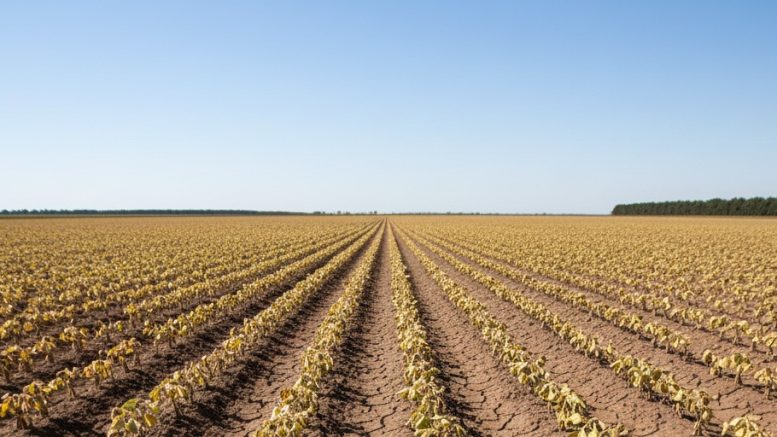“The delay in planting may reduce yield potential and compromise the window for the second crop…”
Luiz Gustavo Moretti is the founding partner of Field Science, a startup linked to São Paulo State University in Botucatu and dedicated to testing and validating agronomic research.
Moretti is an agronomist, with a master’s degree in production systems and a PhD in agriculture from São Paulo State University in Botucatu.

Luiz Moretti, founding partner of Field Science
AgriBrasilis – Given the drought in the State of Mato Grosso, does it make sense to talk about crop failure?
Luiz Moretti – We need to separate things. Whenever a crop is under abiotic or biotic stress, there is a reduction in productive potential. But “crop failure” is usually used when there are long periods of stress—prolonged drought, many cloudy days, etc. So far, we are not facing stress prolonged enough that it would justify talking about crop failure, but rather some level of stress on the crop, which can reduce productivity, but not to levels that indicate large percentages of failure.
AgriBrasilis – How has the drought affected the initial development of crops?
Luiz Moretti – Drought, an abiotic stress, is currently one of the main problems in all producing regions of Brazil. When it occurs during planting, sowing, or harvesting, the effects are even more evident. It is critical during crop establishment because the initial plant population is one of the components that determines productivity. If I don’t have an adequate initial population, this affects the final population and interferes with productivity. It is only one of the components of production, but it is one of the main ones.
AgriBrasilis – Which regions of the state were most affected?
Luiz Moretti – The regions most affected in the State of Mato Grosso by the dry spells so far are those in the central-western part of the state, a transition zone that still contains many areas of the Cerrado biome. Further north, the Amazon climate predominates. Therefore, this central belt, toward Tangará da Serra, is where the dry spells have been most severe.
AgriBrasilis – Could the delay in planting compromise the productive potential and the window for the second harvest?
Luiz Moretti – Absolutely. Delays in planting can reduce production potential and compromise the second harvest window. Soybeans have a very well-defined sowing window in the main regions, such as in the State of Paraná and Mato Grosso. If I delay too long, for example, by starting sowing in the second half of November, I end up compromising the sowing window and the second corn harvest. In the State of Paraná, late corn, sown in late February or early March, is very susceptible to frost. In the State of Mato Grosso, corn sown during this period is much more prone to water stress and drought.
AgriBrasilis – How does water stress interfere with nutrient absorption and soil microbiota?
Luiz Moretti – Water stress interferes with nutrient absorption because many nutrients reach the roots through mass flow, which depends on water in the soil. Magnesium is an example: magnesium comes into contact with the roots via mass flow, so if there is no water, the plant cannot absorb this nutrient. I may have soil with adequate fertility, but for these mass flow-dependent nutrients, without water there is no absorption, and the plant may show symptoms of deficiency.
Moisture is also essential for the microbiota. These microorganisms survive best in temperature ranges around 25 to 28 °C, with organic matter and oxygen in the soil. During prolonged periods of drought, the population of many microbial groups decreases because the environment is no longer favorable. Under drought and very hot soil conditions, we lose microbial diversity, precisely because there are no adequate conditions for their development.
AgriBrasilis – What management practices can help reduce losses and preserve soil fertility?
Luiz Moretti – The practices are well known, but rarely applied. The no-till farming system itself is almost 50 years old, but we rarely follow the three pillars properly. We do a lot of soybean-corn succession, but we hardly ever rotate crops with cover crops to break the cycles of pathogens and diseases in this soybean-corn combination.
Today, we confuse succession with crop rotation: succession is repeating soybeans and corn; rotation involves introducing cover crops and other species. Important practices include: crop rotation, minimizing soil disturbance, keeping the soil covered with mulch and organic matter, storing carbon and building a good chemical and structural profile without physical restrictions. These practices are well described but rarely used and they help reduce losses and preserve fertility.
AgriBrasilis – Can climate irregularity increase pest and disease pressure?
Luiz Moretti – Yes, climate irregularity can increase pest and disease pressure. In very high temperature conditions, there can be imbalances between natural enemies and species that are pests or pathogens. By altering the biological cycle of these natural enemies in relation to pests and diseases, there can be a very drastic increase in species that are harmful to production systems.

